P&O S.S. Arcadia 1954 to 1979
Please Note: Firefox and some other Search Engines may not be suitable
Use Google Chrome for this Web Page to load perfectly!
Please Note: All ssMaritime and other related maritime sites are 100% non-commercial and privately owned, thus ssmaritime is NOT associated with any shipping company or any other organisation! Although the author has worked and been involved in the passenger shipping industry for well over 60 years, but due to his old age and poor health, he was forced to retire. Yet, he has completed well over 1,550 Classic Liners, Passenger-Cargo Liners as well as humble converted C3 converted Migrant Liners, which has transported countless thousands of folk to the new world, as well on vacations’. Amazingly, ssmaritime.com has received well over 573.4 million visitors to date I trust the features online will continue to provide Classic Liner and Ship enthusiasts both the information they are seeking, but more so provide a great deal of pleasure and relive many happy memories!
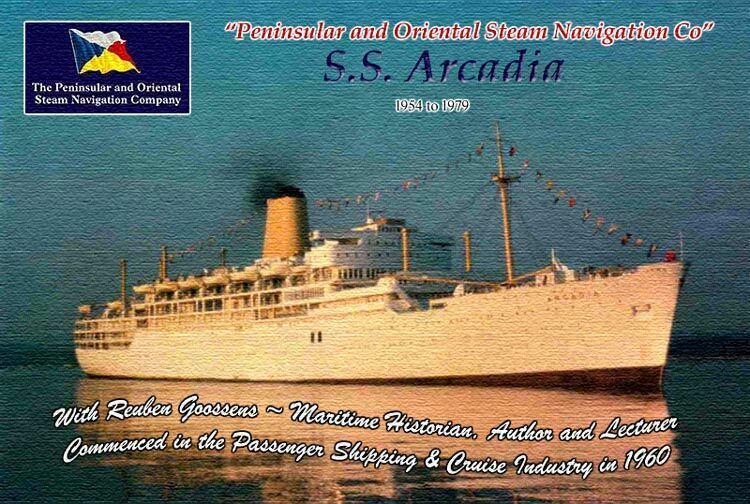
I am
sorry if some of the images shown may not be of the highest quality, but they
are the best that were available
On this page you will find that I will cover
two P&O ships named the “
Page One
S.S. Arcadia (I)
The “Peninsular and Oriental Steam
Navigation Company” placed an ordered for their new liner on November 5,
1886 to be built by “Harland & Wolff”,
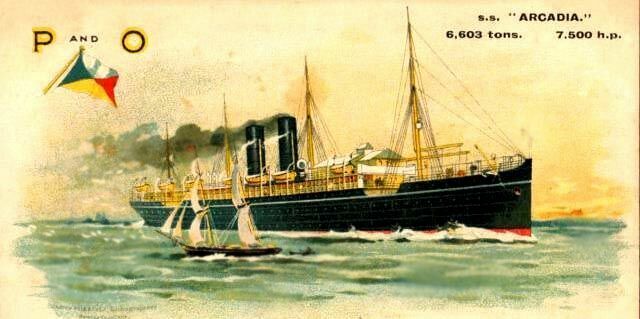
A fine colour P&O Postcard of the S.S. Iberia (I)
She had accommodations of 250 First Class and
171 Second Class passengers. She had a crew of 238, being made up of 83
Europeans and 155 Asians. And there was a cargo capacity of 188,311 cubic feet
- 5,738 cubic metres.
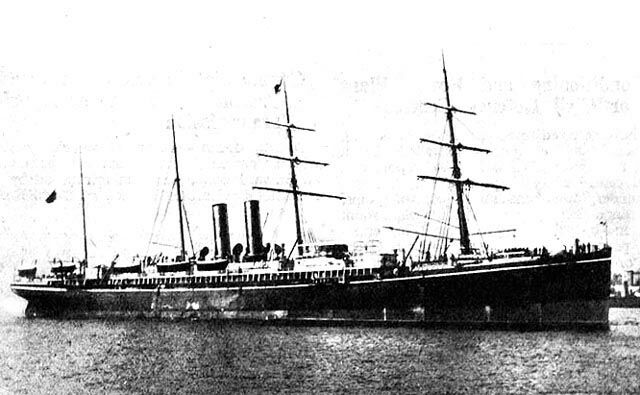
Photograph of the S.S. Arcadia (I)
On June 1, 1888 she departed on her maiden
voyage to
*********************
From Construction to Her Sea Trials:
The “Arcadia” was built for P&O by “John Brown & Company” at Clydebank in Scotland, at an estimated cost of UK£6½ million. She was laid down in Yard 675 on June 28, 1951 and work continued until she commenced to look like the hull of a big liner.
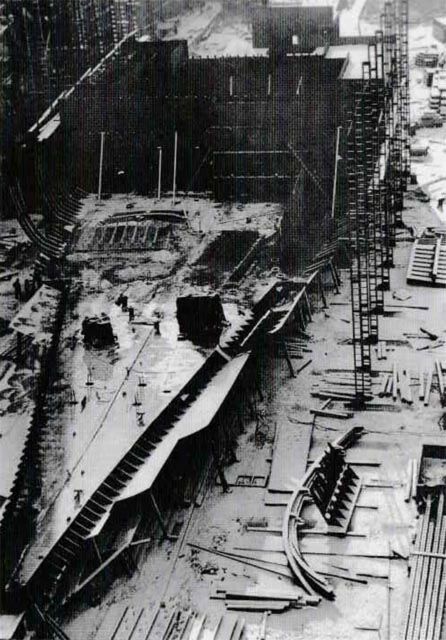
She is seen taking
shape covered in light snow in January 1952
The fact was, for the British Shipbuilding
Industry May 14, 1953 was a huge day, for not only was the “675”
being launched at the Clydebank, but just several hours later at
“Vickers-Armstrongs” at
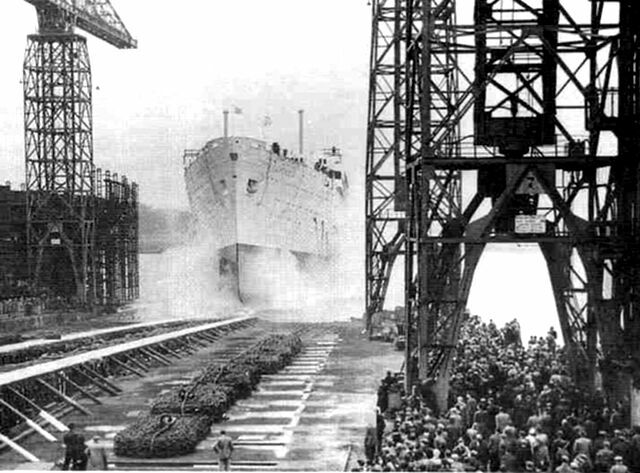
Here we see the
“
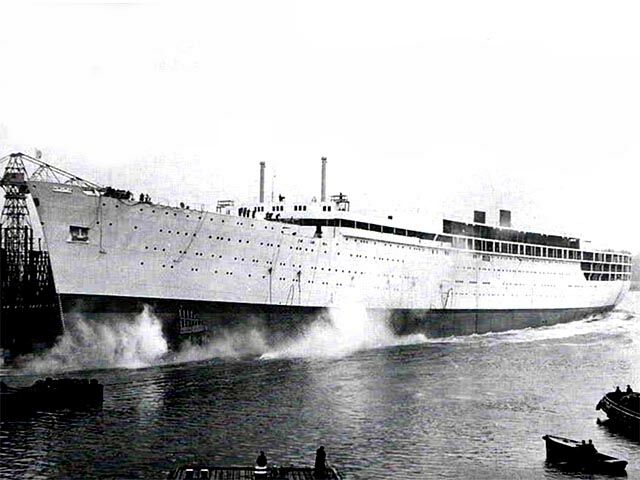
The “
Will be taken in
tow and take her to the “John Brown” fit-out berth.
On January 20, 1954 the “Arcadia’ was able to leave the Clyde under her own steam and head south for Gladstone Dock at Liverpool, where she entered dry-dock. Here she had her “Denny-Brown” stabilizers fitted and her underwater hull was also painted.
There were new innovations to her
accommodations and it reflected the changes in sea travel since the “
She was powered as follows; the main engines installed were two sets of Parsons double reduction geared turbines, 42,500 SHP, and there were three Foster Wheeler controlled super-heat boilers of 600 psi.
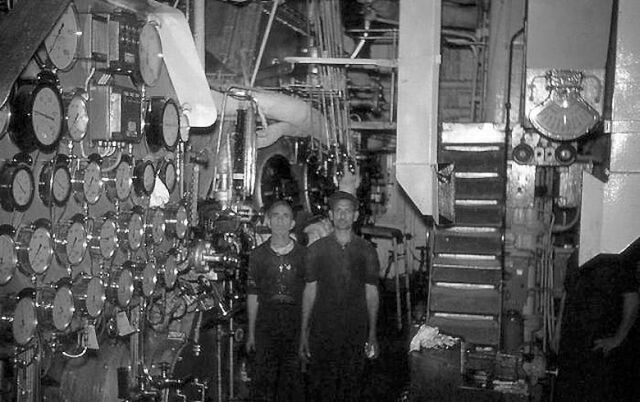
Boiler room crew
As a twin screw ship she had a good service speed of 22.5 knots, but her maximum speed was better as we will see below.
When completed, she headed north again and on
January 26, 1954, she commenced her official trials on the
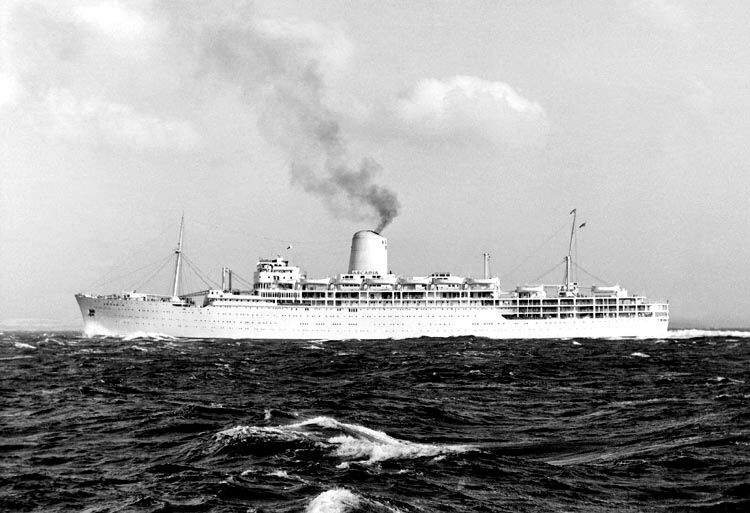
The S.S. Arcadia seen during her speed trails, note her still unpainted funnel top.
The S.S. Arcadia was delivered to P&O at
Clyde on January 30, 1954 having cost
On the very evening the “
There was no doubt that all guests were most impressed with the ship and her excellent Public Venues, and the deluxe Staterooms they had occupied as well as the fine First Class cabins, etc. Even the Tourist Class facilities were rates as being in a very high standard!
*********************
Tour of the Ship:
As always I will commence topside and far forward and will always slowly head aft and then go down deck by deck. First Class facilities and accommodations were all located six decks, being on Boat Deck, Promenade Deck, as well as A to D Deck’s. Of course I will cover First Class First and then the Tourist Class, etc.
First Class
The Bridge and the two Associated Decks:
The Bridge is the place of 24 hour activity and it keeps the ship on course as there is a helmsman and an officer always on duty, as well as others including the Captain at various hours when he is not in his offices or doing any of his other many duties. The chart room is also attached aft of the Bridge.
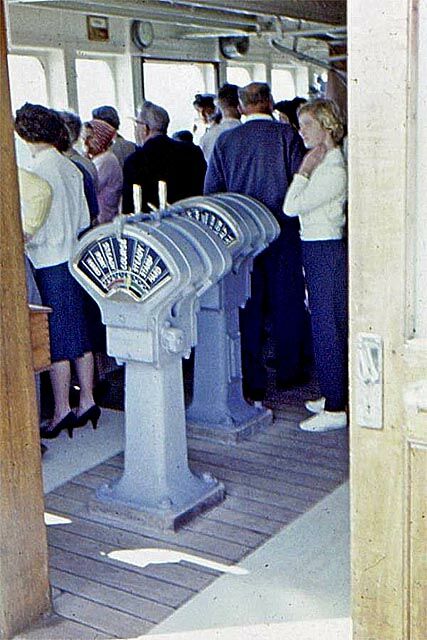
Visitors on the
Bridge, this time whist she was in port
For information: Far forward on the same level as Boat Deck but completely separated, is an “Observation Deck”, and this deck is located above the “Children’s Playroom”, which is located far forward on Promenade deck, and the Observation Deck can only be reached per the two stairways on the either sides outside of the playroom deckhouse.
Boat Deck:
Forward is the main arrival point to this deck, which is via the forward Main Foyer’s stairwell and it is certainly the best way of reaching Boat Deck. Beside the stairs are two Lifts (Elevators). (This stairwell commences at A Deck and goes up to Boat Deck on Adeck another stairwell in the same lobby goes down to D Deck).
There was no doubt that this was an extremely popular destination, and you may ask why? Well, it is because forward on this deck was the spectacular “Observation Lounge” and Bar!
Observation Lounge:
Large tall windows were set in the in the forward and rounded side bulkheads of the venue providing sensational views. Along the windows there were comfortable armchairs each having footrests. In the center of the venue on the aft bulkhead was the Bar and it was decorated on both sides with a large figurehead being a traditional representation of those that used to be betted on old day sailing ships.
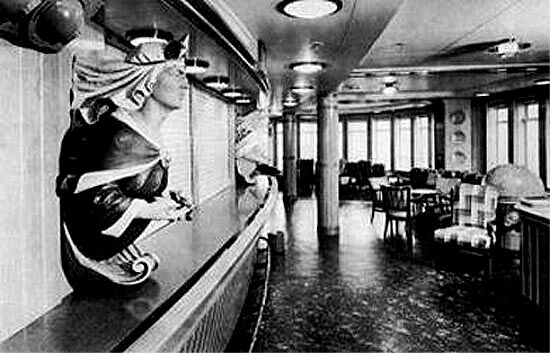
The centre part of the “Observation Lounge showing the venue, windows, Bar and the figureheads
In addition there were also terrestrial and celestial globes in the venue, whilst the deck covering on either side featured maps of the two hemispheres.
This venue was wonderfully casual in feel, yet so exciting in so many ways, as the furnishings, although designed to look casual, all chairs were supremely comfortable, and thus this venue proved to be one of the most popular venue of the entire P&O fleet!
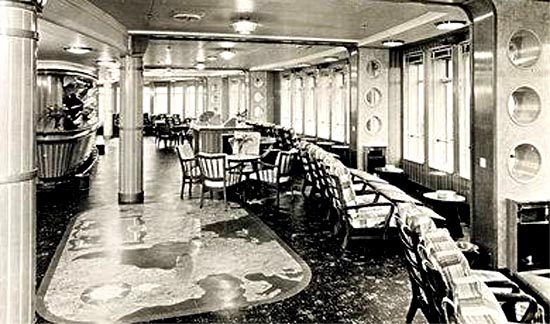
Here we see the starboard side and the map on the floor
Sports Deck:
Heading out trough the Foyer doors facing aft on either side of ship, we arrive on the huge ‘Boat’, or better termed as Sports Deck!
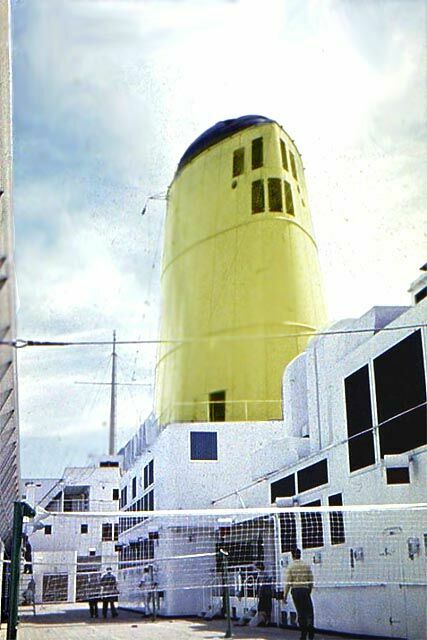
A view forward with the doors entering Boat Deck from the Foyer
Note the sliding glass
screens just out of view to the left.
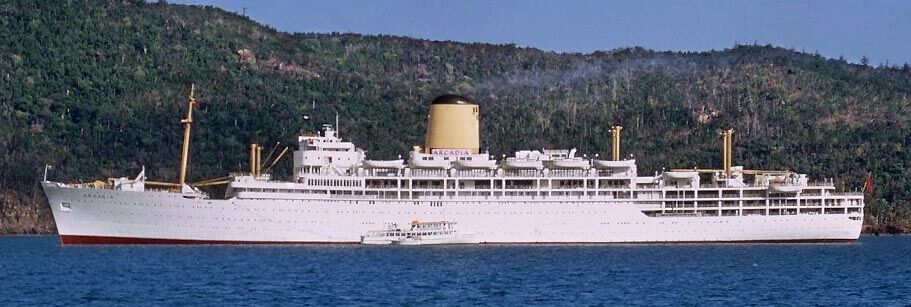
This image of the
“
This is a most spacious deck and it is fully screened by glazed screens that can slide open and be shut when it is windy, thus making the deck a very useful space for sports, or just relaxing, whilst on the exterior side of these screens becoming an excellent promenade.
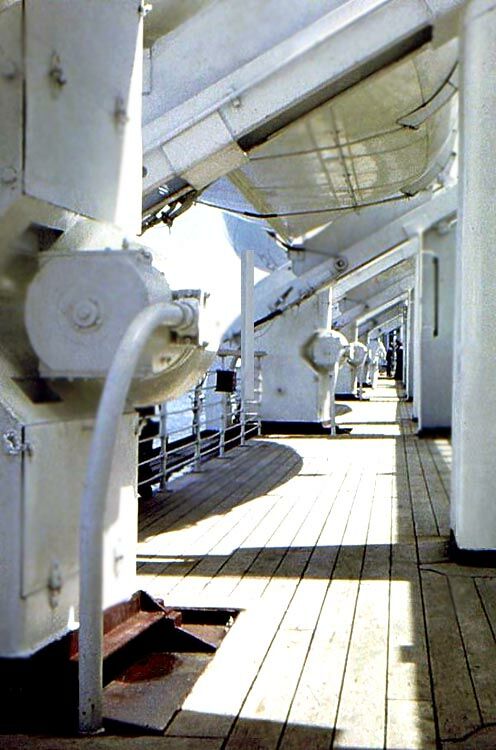
The walking Deck
outside the sliding glass screens
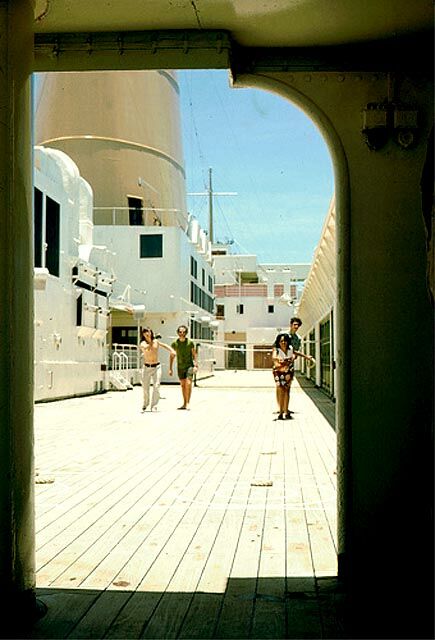
Above & below: Two fine views showing the port side with both the shuffle board games
and the deck
tennis courts, with the bottom photo being taken from the Bridge wing
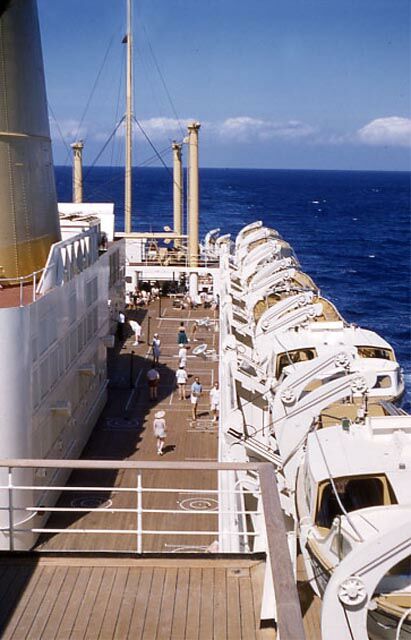
Carefully placed on the deck are four shuffle Board games on both sides of the ship, and a little further aft there are four Deck Tennis Courts on each side. These can be used as desired, or will be used during organised during the Entertainment Director’s Tournaments.
Although I mentioned that Boat Deck can be reached via the forward Main Foyer, however there are also stairs on both sides far forward and aft along the superstructure of the Promenade Deck.
Promenade Deck:
Children’s Playroom:
As I already mentioned earlier far forward is the location of the Children’s Playroom and their own spacious screened off deck space. To reach this facility, there was a staircase on the starboard side far forward near the second cabin from the front, but on the interior side that went up into the playroom.
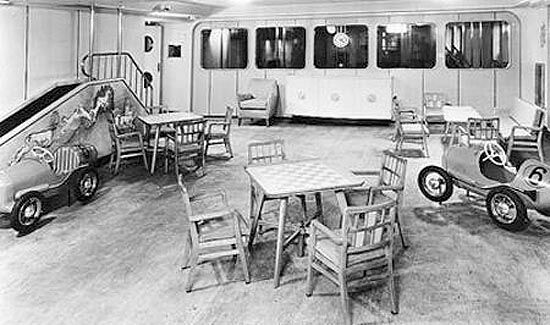
The Playroom is divided by a wall with five windows in it, into two separate spaces for this enables the hostess to separate children of different ages, the starboard section was for the younger set, and the port side for those that were somewhat older. WC facilities were available for the children and outside the play area was retained to the middle of the deck. This was done so that passengers could reach the “Observation Deck” or use the front stairs to the Boat Deck.
Like everything in First Class the forward Main Foyer and its Stair Well and it lifts were the means of reaching everything on the ship. Although there where stairs on the port and starboard sides amidships in the hall between the Lounge and the Ballroom.
Writing Rooms and Library:
Located directly forward of the Promenade Deck’s Main Foyer were the Writing Rooms, which were located on both sides of the ship, and yes there were two, and in the centre was the larger venue the Library.
The Library was the only one that was open to the Foyer, as it had a balustrade and two round columns which made the entrance. On the two sides were large bookcases, and with a large carpet covering most of the venue and the comfortable furnishings the venue was very pleasant indeed!
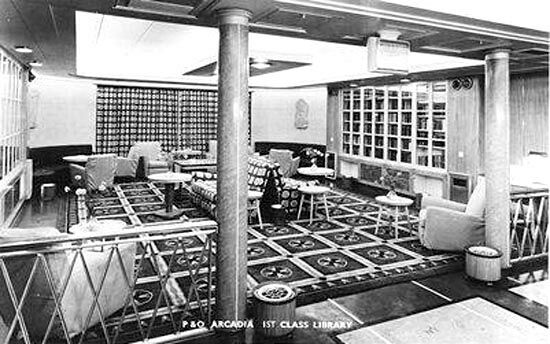
The Library
The furnishings were in shades of lichen and moss green, with contrasting gold, orange and beige. In the evenings the curtaining provided a wonderful expanse of colour in a contemporary design.
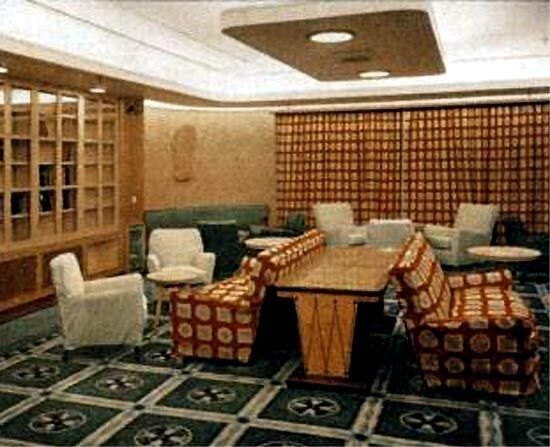
The Writing Room were of course enclosed venues and its furnishings were of sycamore and walnut, and there were single and double writing desks, with occasional tables and chairs. Whilst the colour scheme was the same as the Library.
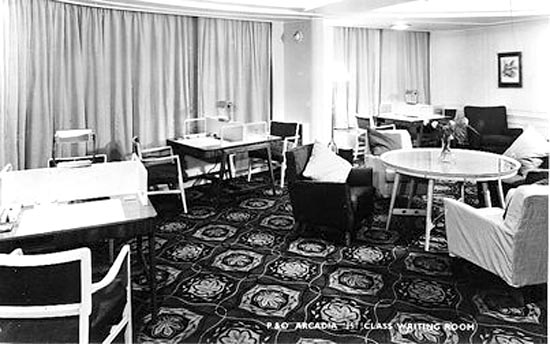
The Writing Rooms
As we return to the Foyer, we continue aft and in the short port and starboard passageway are wide doors which lead into the large Lounge.
The Lounge:
As soon as one enters it is most notable of the vast number of windows along the sides of the venue. One on the rooms special features was on of a special feature of the ceiling was a circular shape with a panelled perimeter all arranged to carry concealed lighting for general illumination. This was so new for the times!
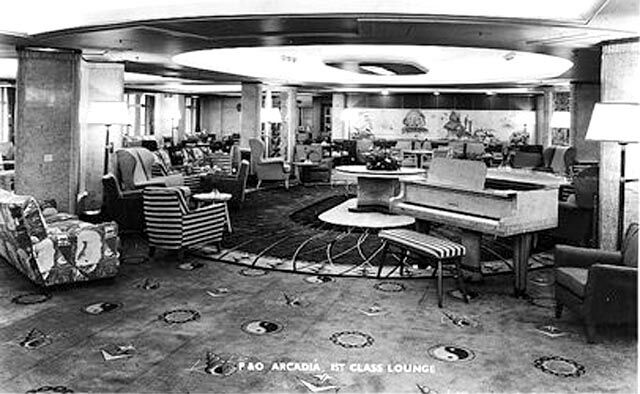
The Main Lounge
The room had varied areas that inlaid relief’s including one of a mural featuring an ‘Arcadian’ scene.
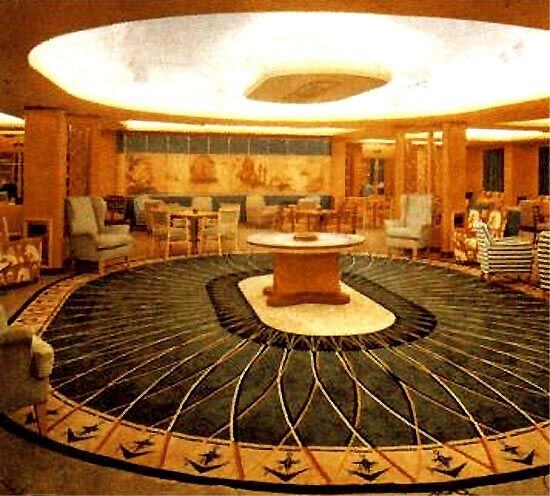
A colour view of the Lounge
Aft of the room on both sides were the two short hallways with stairs down, and doors that led into the Ballroom.
The Ballroom:
This venue was without a doubt a large venue, and like on all P&O ships it was decked with teak timber, the same as the exterior decks, and the sides were the folding timber framed glass screens that could be opened during fine weather, or kept shut. The Musicians platform was located at the forward end between the two entrances. Also forward but on the starboard side was the steward service only Bar that serviced the Lounge, Ballroom and the deck outside when passengers were relaxing there.
The Ballroom was obviously the main dance venue, as well as the space foe games such as Horse Racing, and so many other fun shipboard games that are held during a long voyage! Fancy Dress parties, for adults and children are held here, etc, thus it is a venue well used!
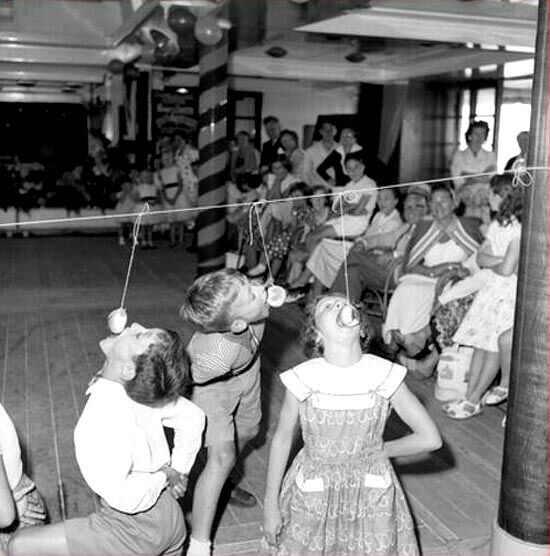
A special
Children’s party is being held
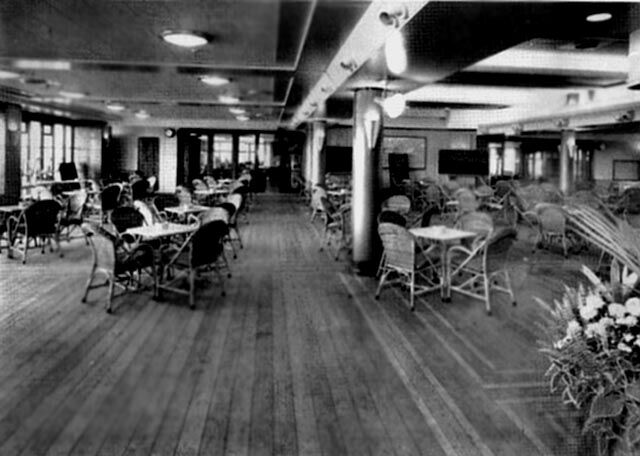
Ballroom looking aft
Aft of the venue were large sliding glass doors that led into the wonderful Verandah Café.
Verandah Café:
This beautiful venue served as the first Class Main Bar as well as the Smoking Room. It had two wide bay windows, with panelled, pillared surrounds, which were outstanding features of the room. The centrally located Bar faced forward to a decorative panel representing a chart of the world.
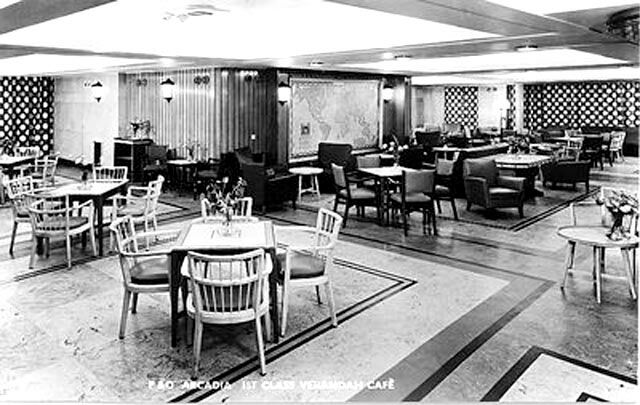
Pool Café:
The Bar being the same one as in the Veranda café as it was located in the middle of a very large venue, and the front was the in Verandah Café, and the aft in the Pool café.
Two Panels on the front of the Pool side of the Bar depicted scenes of the Grand Canal of Venice and it was spectacular! The room had much the same look as it had much the same furnishings, etc.
Swimming Pool:
Directly aft of the Pool Café was the pool, which was surrounded and sheltered by male and female changing rooms and an attendant room.
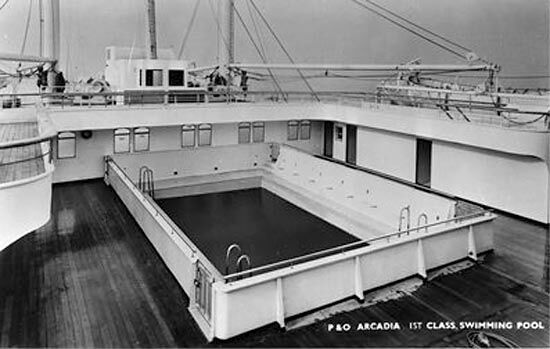
The Pool
Promenade Deck:
The
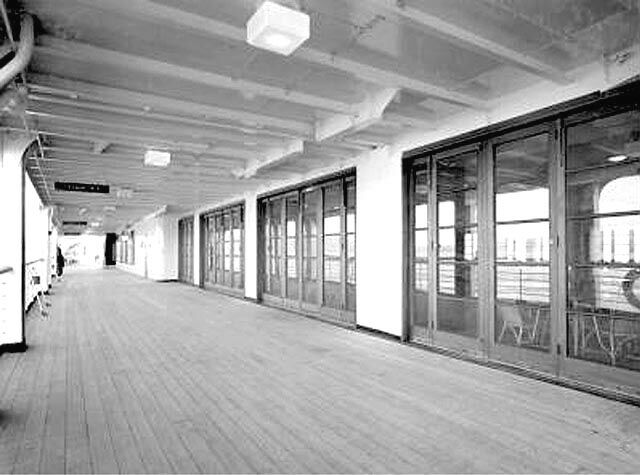
Starboard
Promenade Deck and here we see the Ballroom screens that can open or stay shut
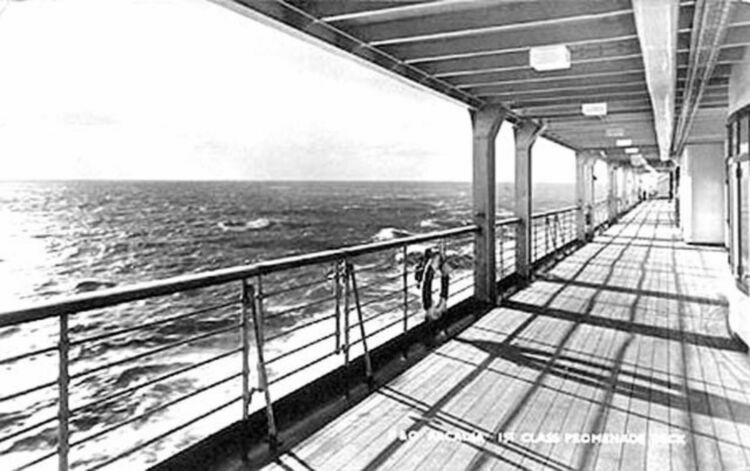
Another view of the deck, but of course when it is warm weather
it is filled with deck chairs for passengers to relax in!
A Deck:
First of all the Stairs from Boat, Promenade Deck down to A Deck, with the two Lilts at its sides ends on this deck, whilst the Lifts continue of course, but a new stairwell commenced just forward on this Foyer that goes down to B, C and D Decks.
This deck offered an excellent variety of well appointed cabins, from single bed cabins with either a shower or a bath, or twin bedded rooms with either private or shared facilities.
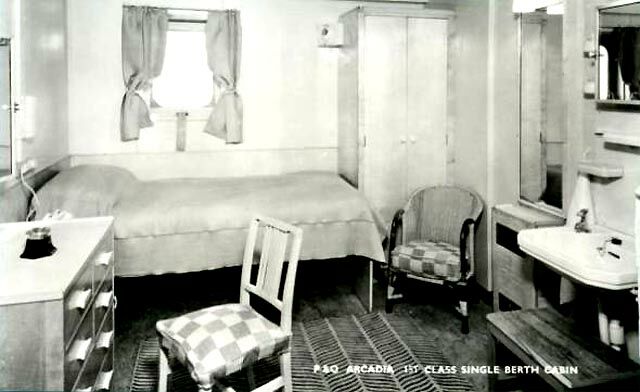
A single bedded cabin on A deck with a bathroom
Whilst aft of the Foyer were several ships Shops, followed by the Men’s Hair Dresser and the Beauty Parlour. Whilst amidships on both sides there were stairs that went up to Promenade Deck and down to B and C Decks.
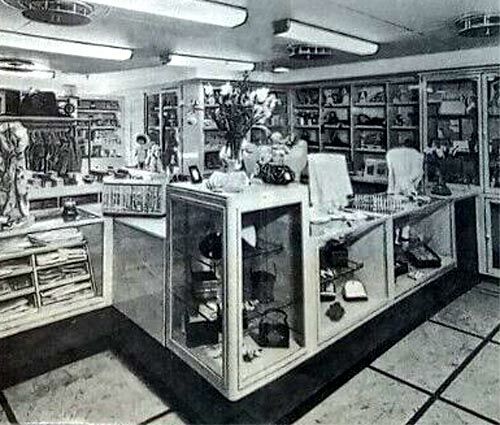
This is just one of the shops
Then far aft of the cabins was another foyer, although the stairs here could only be used to go up one flight to Promenade Deck, for the rest of the stairs below were all for Tourist Class. On the starboard side of this aft foyer there was a narrow entrance, into what was a new innovation for a P&O ship, for the “Arcadia’ had been fitted with a dedicated Cinema. Sadly no photograph is available.
B Deck:
On this deck there were eight Deluxe Staterooms, which were fitted with retractable beds thus the room could be converted into a spacious sitting room. Also these rooms were interconnecting, thus they could be booked as one large suite if required and all were fully air-conditioned as were all the First Class inside cabins.
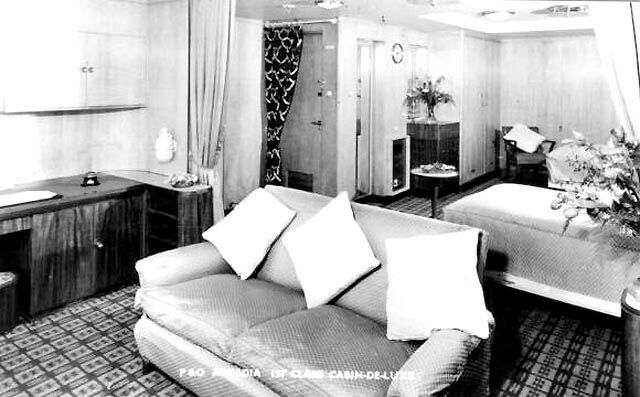
Above &
Below: Two views of the Deluxe Staterooms
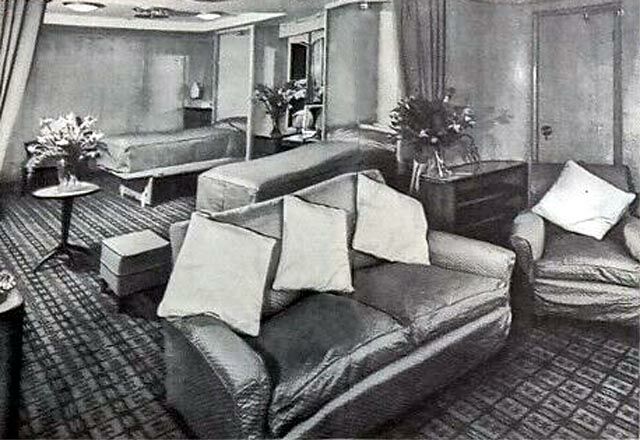
Further aft was the location of the Pursers office, which was so located that it was assessable to both the First Class on the forward side and the Tourist Class on the aft side, but neither could see each other. The aft staircase was only used in the Tourist Class section.
C Deck:
The Foyer here happened to be the First Class Entrance Hall, thus being very spacious. Forward of the Foyer was a block of cabins, and those aft of the Foyer only reached to just amidships. Then on the portside was a large Medical Centre and Doctors office and his Surgery, etc, apart from this not much of interest here.
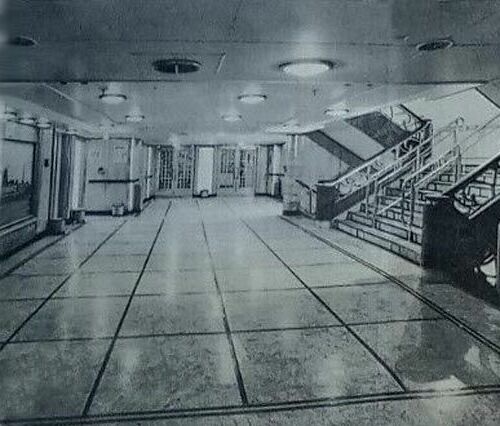
The Entrance Hall looking to port, with the staircase forward
And the two Lifts are on either side of the centre bulkhead artwork
D Deck:
Again cabins were forward of he Foyer but the Min feature n this deck was what was directly aft of the Foyer.
Dining Room:
The Dining Room was entered from the Foyer through two rotating doors located on the either sides on, although they could be folded away to make an fully open entrance if required. The Dining Room occupied the full width of the ship and was close to 1,000ft in length. The venue was able to seat 366 guests at tables for two, four and six, and there was a raised central section, which enhanced the feeling of spaciousness.
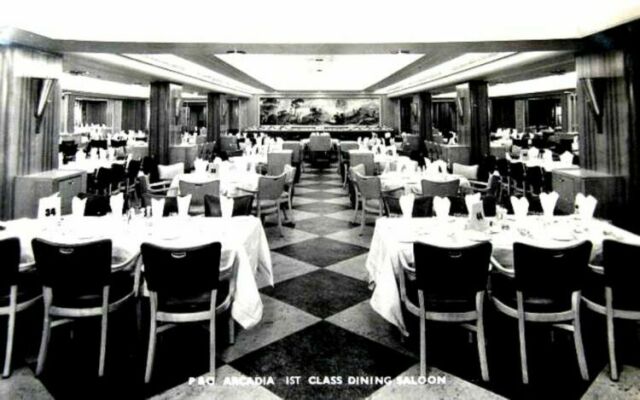
Above &
below: The Dining Room
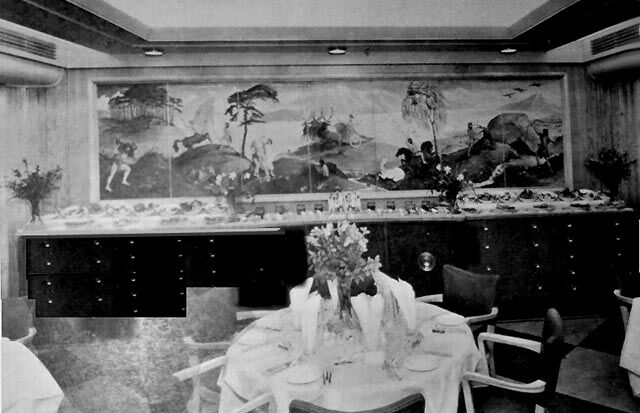
Timber was heavily used throughout the room, and the floor had large two tone vinyl tiles, the ceiling featured concealed lighting throughout and it had an overall pleasant effect!

A bookmark
obtained from the Writing Room
*********************
Tourist Class
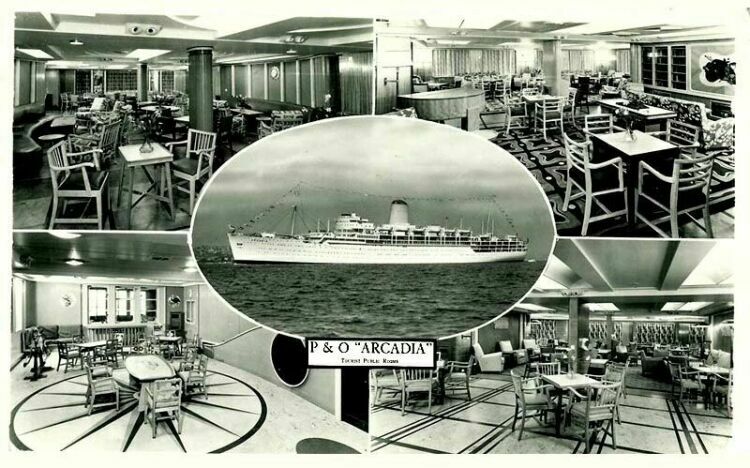
A popular postcard obtained on board
Tourist Class facilities and accommodations were all located aft on seven decks commencing on Promenade Deck, and A to F Deck’s.
Promenade Deck:
Pool and Deck Space:
Between the First Class Bulkhead and the back of the Pool Changing Rooms that actually face to the rear, was the entrance to the Tourist Class far aft stairwell, which commenced here on Promenade Deck and went all the way down to F Deck.
Aft on this deck was the Tourist Swimming Pool with the changing rooms located forward of it, bat as I already said faced aft. The pool was surrounded a very spacious deck and there was ample room for lazing in the sun and enjoying sports activities!
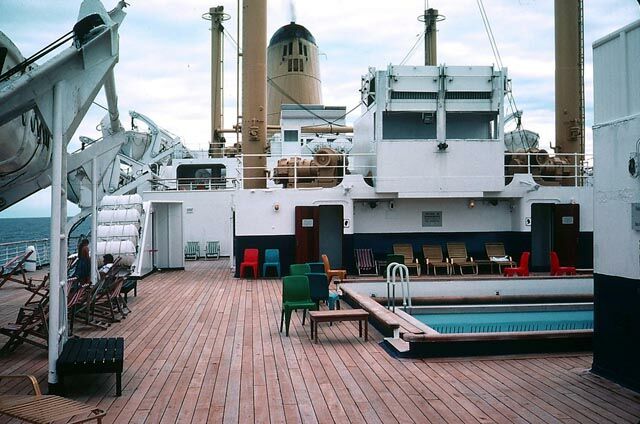
The Pool
B Deck:
As I already mentioned earlier forward of the Tourist Class section, being also the aft of the First Class on this Deck, was the Pursers Office, which had an opening on both sides thus serving both classes. There were no Tourist Class cabins on this deck, however there was the aft Tourist Foyer with the Stairwell and a single Lift that went down to F Deck.
However B Deck did have several public venues!
Ballroom:
The first venue directly aft of the Foyer was the Ballroom, which was very similar to the one in First Class, having teak planking and the band stand was located on the forward bulkhead and there were glass folding screens along both sided, so they could be opened or closed. Aft on the portside was the steward only service Bar. Sadly there is no image available.
Verandah café:
Wide glass doors from the Ballroom on both sides allowed entry into the Verandah Café and this venue was decorated by light-coloured veneers of zebrano and ash and pale grey-green leather-covered panels.
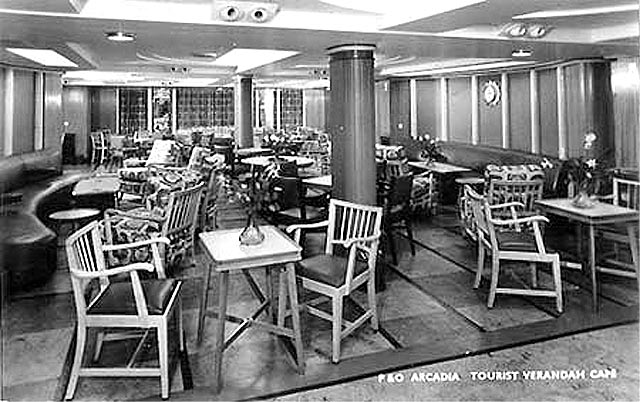
The Verandah Café
In the middle of the room there were curved alcoves which had built-in divan seats.
Of course outside there was a covered Promenade Deck
Aft of the Café was the Children’s Nursery.
Children’s Playroom:
This playroom was decorated with native Australian native birds and animals. It had a slide on the forward bulkhead, a rocking horse and ample tables and chairs. There was an exterior playground, again well screened for their safety. The usual facility were also includes of course.
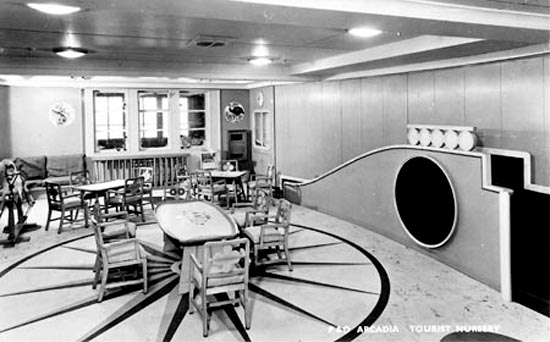
The Playroom
C Deck:
Aft of the Foyer, besides a spacious Promenade Deck, there were two spacious venues, the forward one was the Tourist Class Lounge.
The Lounge:
The Lounge featured large casement windows on the two sides overlooking the covered Promenade deck and the sea. The timber panelling was in figured French birch, with contrasting elm, whist the windows were framed with sycamore.
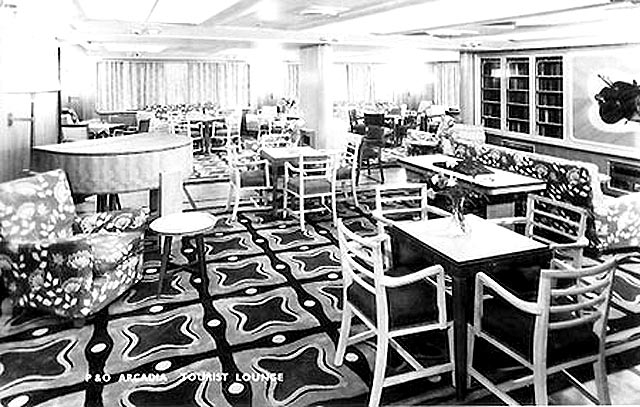
A light and bright Lounge
The cupboards in this venue had decorative marquetry set into the door fronts as well as the sides of the central casing. Decorative features were to be found along the walls. A grand Piano was locates near the aft bulkhead.
Aft of the lounge was there was another smaller lobby, being the aft lobby.
Smoking Room:
The Smoking Room was furnished in light grey, powder blue and ivory. The chairs were covered in leather, and leather was also used in the wall features panels that were set in the bulkheads.
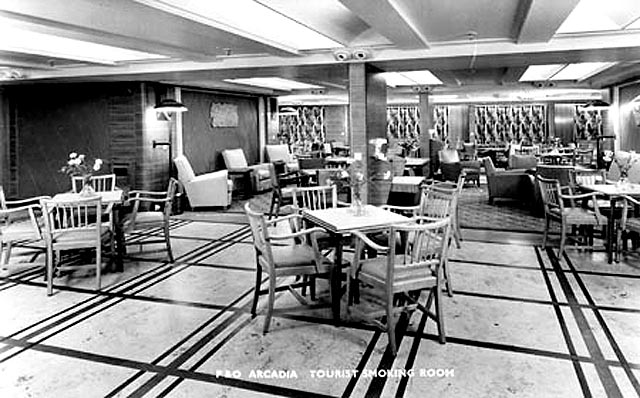
The Smoking Room
These lighter colours were perfectly matched with the darker timbers along the walls, making this an elegant venue!
Of course so far there have been no Tourist Class Cabins as yet, but these come on the next deck.
D, E & F Decks:
Using the far aft stairwell and go just one deck down, you would arrive in the D Deck lobby and aft there are cabins, and forward was the Dining Room.
The other entrance to the Dinning Room would be for those who would have used the forward Foyer’s stairwell or aft lift (the one just aft of the Pursers Office) this would have seen you arrive very much in the middle of the Dining Room. This room was panelled in fine timbers, relieved by designs in quilted turquoise-coloured leather. There was seating for 376 guests at tables for four, six and eight.
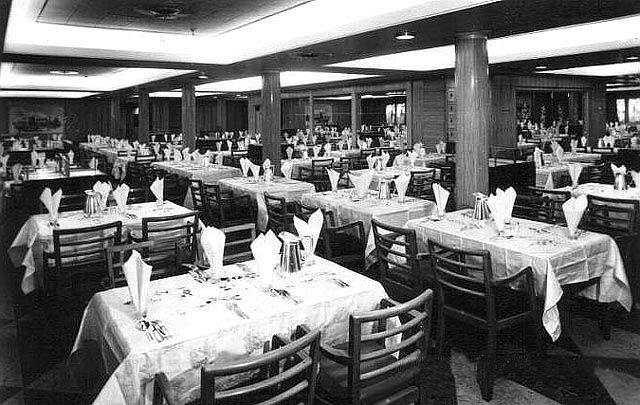
The Dining Room
Aft of the Dining Room on D Deck and on E and
F Decks were all the Tourist Class cabins, which were made up of two, four and
six berth cabins, all with shared facilities. I only have an image of a two
berth cabin below, but all cabins looked similar but were much larger of course.
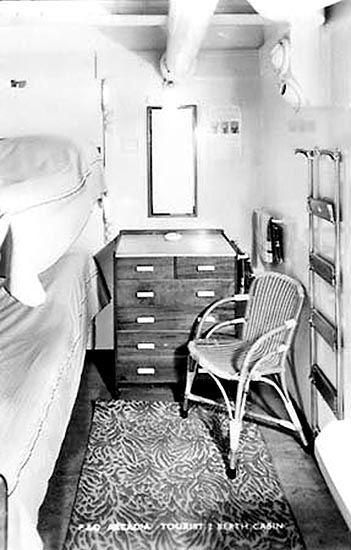
A Two berth Cabin
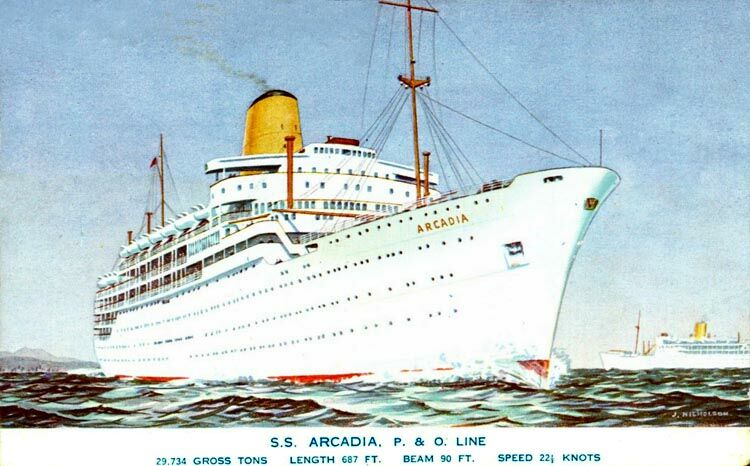
An artistic
postcard of the S.S. Arcadia
*********************
S.S. Arcadia’s Maiden Voyage:
She returned to Tilbury on February 2, 1954 from her three night trial voyage with her pampered guests and once everyone had disembarked, the crew commenced to get the ship ready for her big day, being of course her maiden voyage which was scheduled for February 22.
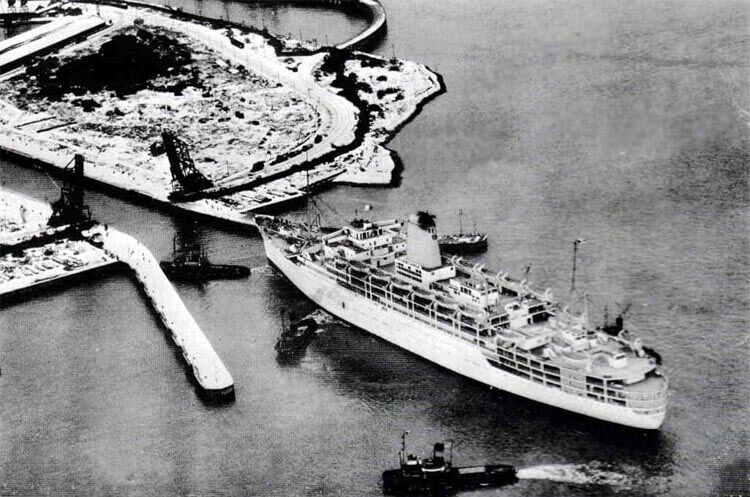
The soot already darkened the aft of her funnel
It would take a good 19 days to get her ready for her maiden voyage as she had to be made completely ship-shape, first of all she was fully manned, and stocked up with all the haberdashery items etc, also cargo was loaded and when the time was right all foods were brought on board and correctly stored in the right placed, etc, and cabins perfectly made up just prior the the departure date. She had to be in perfect condition for her departure, and indeed she was perfection on the day!
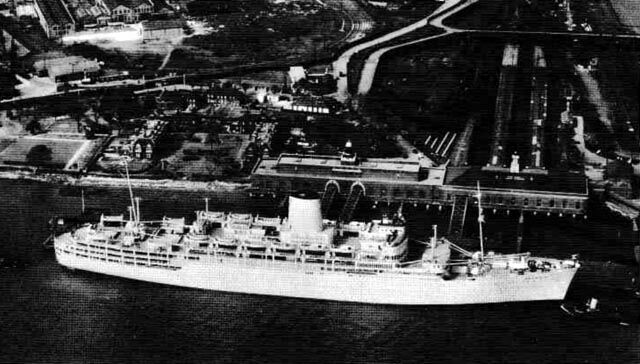
S.S. Arcadia awaiting her maiden voyage at Tilbury Landing
S.S. Arcadia departed on February 22, 1954 on
her maiden voyage from the Tilbury Landing stage, under the command of
Commodore G C Forrest, and she sailed via the Suez Canal,
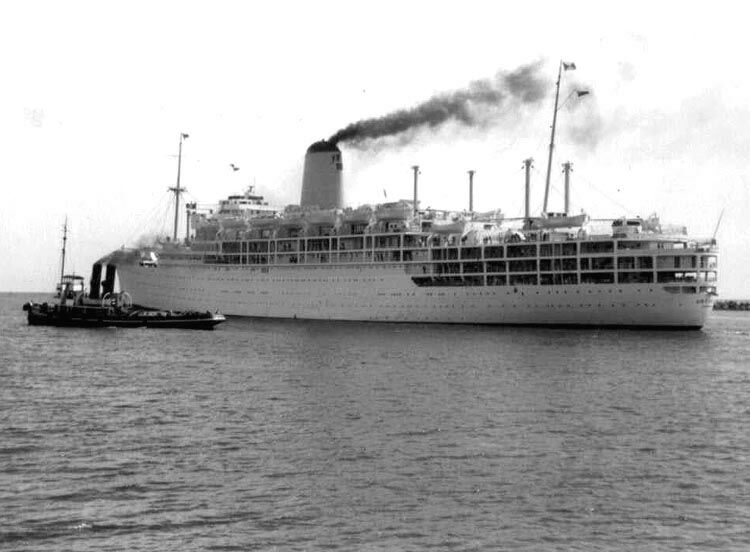
S.S. Arcadia is see arriving at the
Not much later that year the “
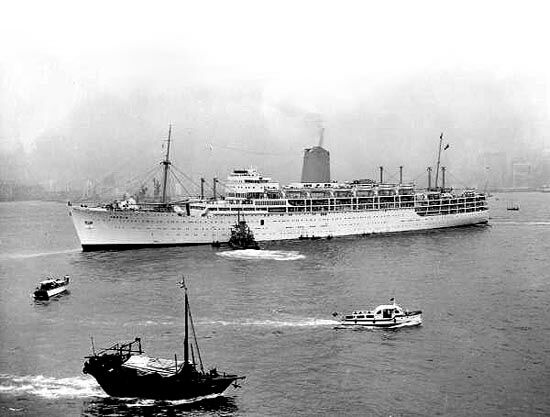
S.S. Iberia made her maiden voyage on September 15, 1954
Following her return to
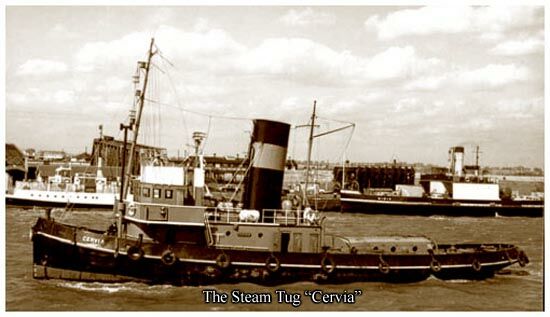
Visit: https://www.thesteammuseum.org/cervia.html
Another Watkins owned tug, the
“Challenge”, managed to rescue three of “Cervia’s”
crew. The subsequent court of enquiry into the case, recorded that the deaths
were accidental, and the sinking was caused by the failure of a quick release
pin on her towing hook.
During one voyage on December 30, 1957 there
were several passengers and crew injured in due to wild gales in the
On April 1, 1959 she arrived at “Harland
& Wolff” in
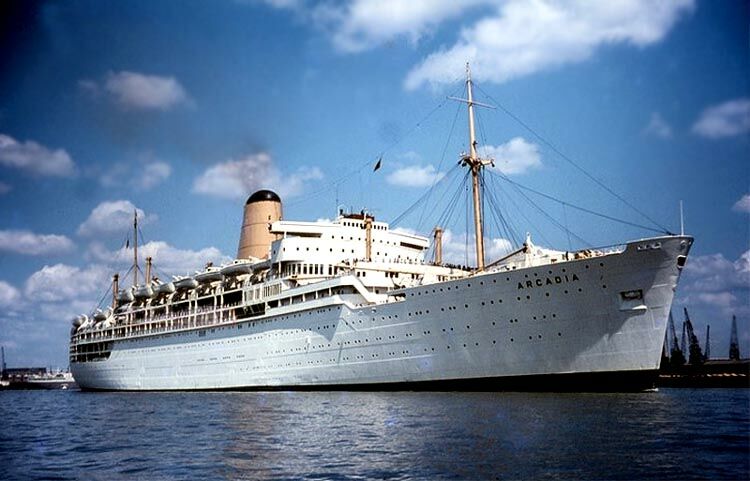
S.S. Arcadia is
seen departing bound for
In November 1959, the “
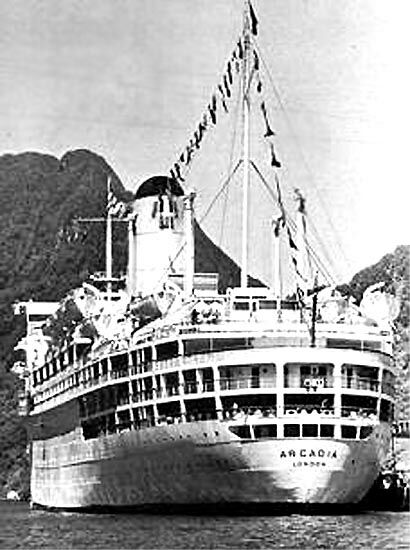
The “
During the 1960’s she kept very busy, both as a liner and cruise operations, she had now become a ship that was cruising visiting so many new ports and the Arcadia was the perfect ship for a great vacation as she seemed to offer a relaxed and yet an active holiday with heaps of fun on the way! She was known as being the “Happy Ship” and we heard that over and over again from her passengers!
The “
Then in May 1960, management and operations
was transferred to the new name of “P&O-Orient Lines”.

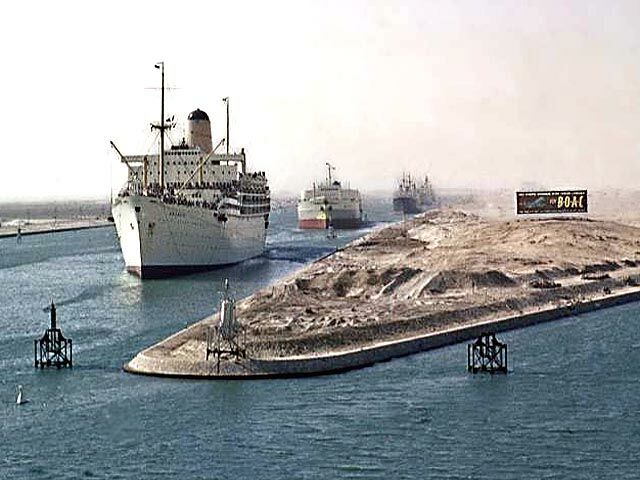
The “
In June 1961, the “
In December 1968 P&O was given clearance
by the
S.S. Arcadia the Cruise Ship:
In April 6, 1970 the ‘”
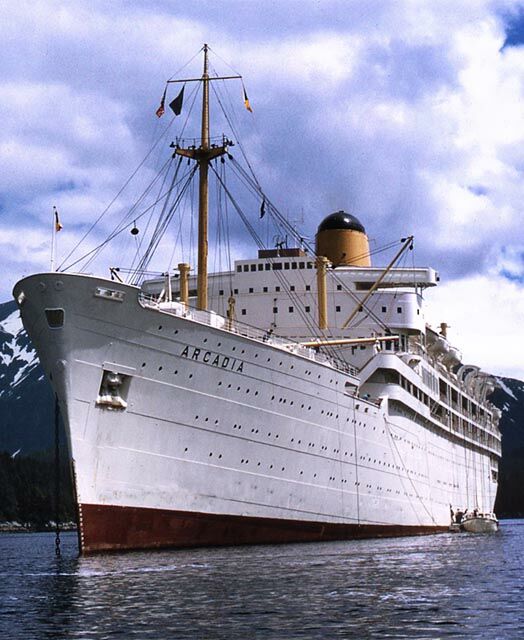
S.S. Arcadia is seen cruising along the Alaskan coasts and towns
On April 26, 1970 the “
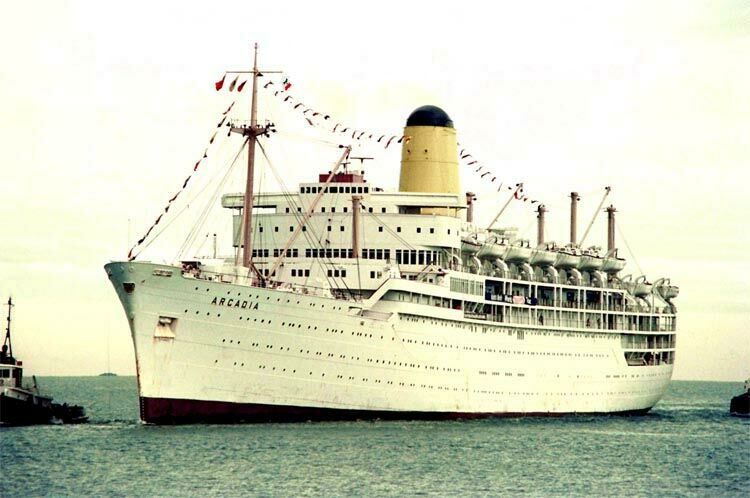
S.S. Arcadia is seen arriving at a Mexican port
Then, on October 1, 1971, there was yet another management change with a new marketing name restyled; “P&O Lines”.
Then in June 1973, the
In October 1974, the 1949 completed S.S.
Himalaya was withdrawn from the Australian cruise trade, and it was decided by
P&O to replace her in
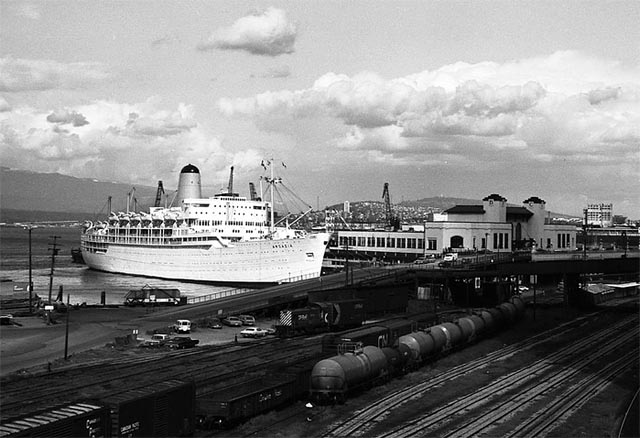
The cruise ship
“
She departed the Southampton,
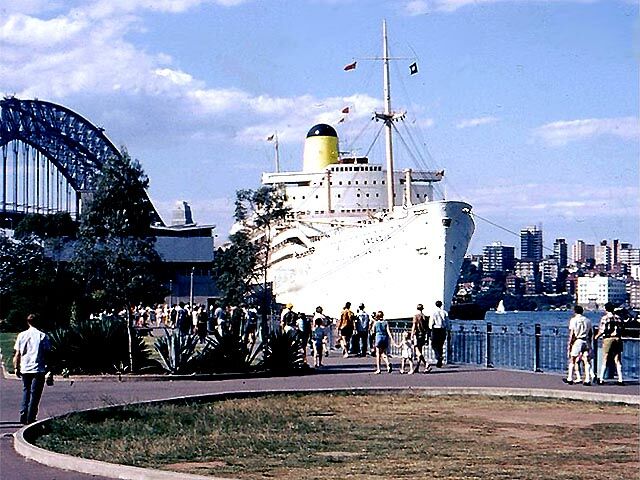
The much loved
“
Unlike her sister, the S.S. Iberia, the
“
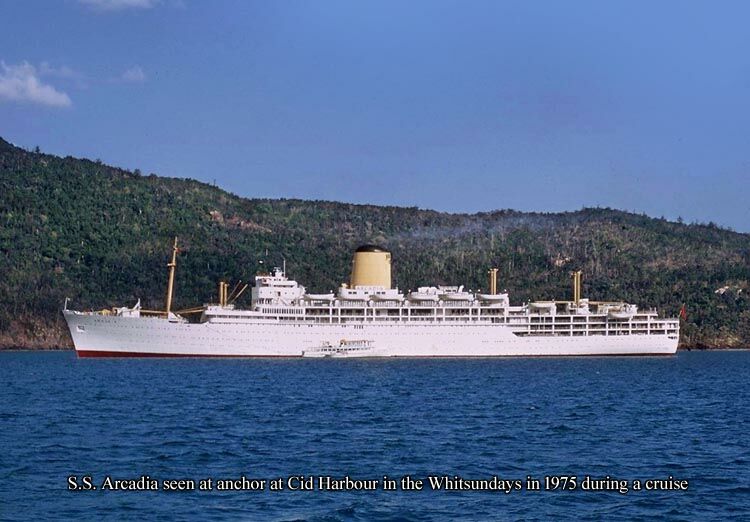
The “
Then in the early hours of Friday June 2, 1978
the “
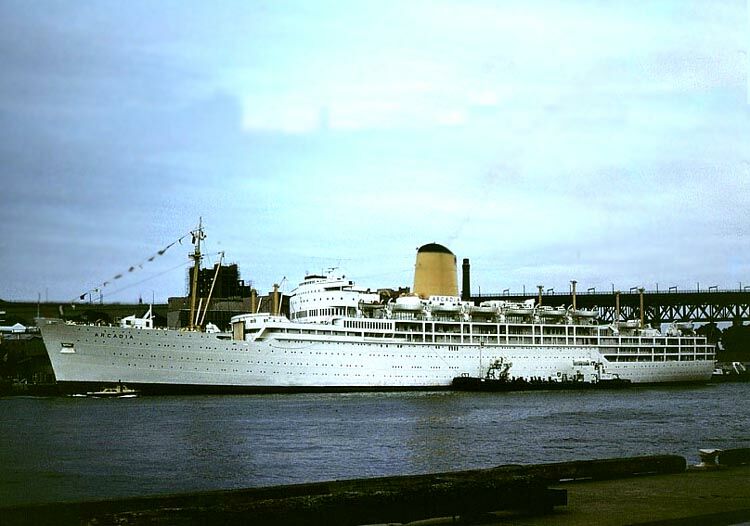
S.S. Arcadia
bunkering at
S.S. Arcadia’s final official Voyage:
On January 28, the S.S. Arcadia was getting
all ready and was bunkering and being fully stocked up for her cruise, it was
such an emotional time on board the ship, but her crew was being very busy as
they had to do everything at their best ability, as their guests would board
her tomorrow and when they would leave her at the end of their
“Arcadia” section of the cruise, this voyage simply had to have
been the very best and the most memorable cruise ever!
Soon enough the day had arrived, and besides the passengers having boarded, there were huge crowds everywhere at the dock and people crowding around the wharves and at the Sydney Opera House, and as far as the Sydney Heads as they wanted to see their beloved S.S. Arcadia sail though the Heads into the ocean and turn to port and head north for Brisbane, her next port of call!
“
Then the time had arrived as she slipped her
moorings and thousands of loud cheers filled the air with the people ashore all
clapping their hands, and the pipe band commenced playing “
The S.S. Arcadia was fully dressed overall and she had her 25-ft paying-off pennant flying ever so proudly from her mast!
For the last time she steamed majestically into the Harbour and sailed gracefully under the Sydney Harbour Bridge being accompanied by an escorting flotilla of tugs, ferries, fireboats, yachts and pleasure-craft of all varieties. Countless thousands gathered at vantage points along the harbour’s edge to wave her a last goodbye.
She looked very beautiful as she passed the Opera House and headed for the Sydney Heads.
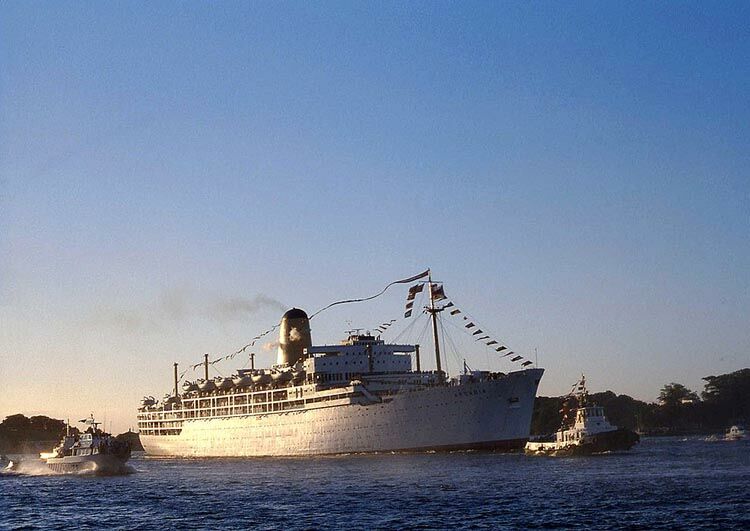
Farewell beloved
old Girl, the
The S.S. Arcadia was fully dressed overall and she had her 25-ft paying-off pennant flying ever so proudly from her mast!
It was a nostalgic
goodbye from a city which had grown to love the ship, and the evening air
resounded to a cacophony of whistles and car horns as “
The small craft, and a fine old steam yacht,
and the tugs followed her almost to the heads with never ending sounds of
whistles, car horns, and the other ships in port also let the “
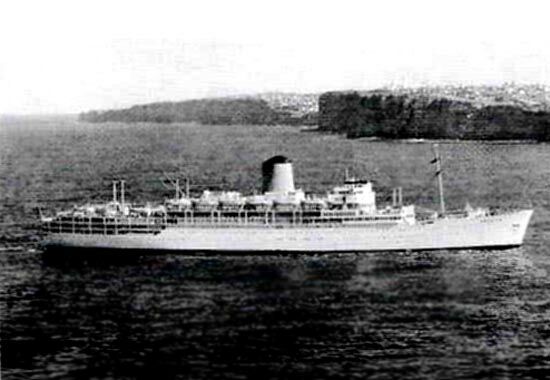
S.S. Arcadia is seen going through Sydney Heads but at an earlier time
Sorry that this is such a poor photograph, but it is the best available
She first headed for the semi-Tropical State
of
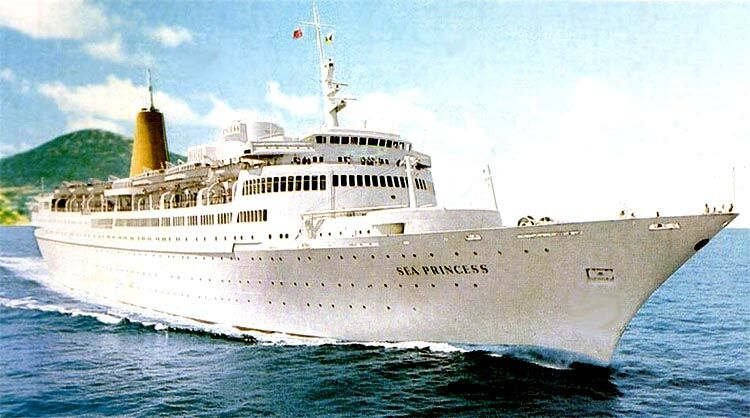
Once everyone who had to leave the ship had
left,
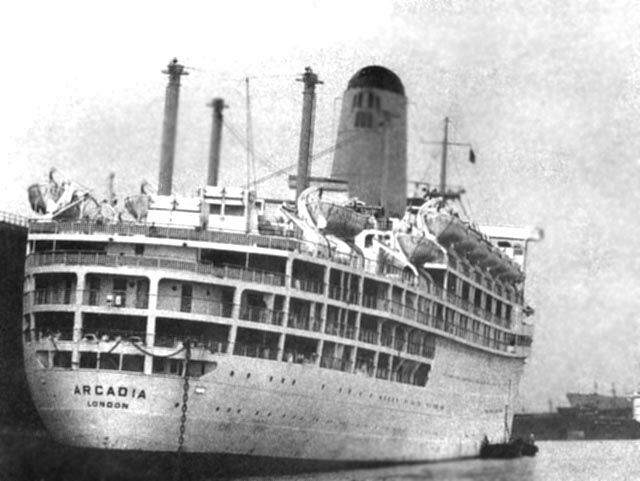
S.S. Arcadia is looking rather sad, for she is seen here at the breakers yard
There in
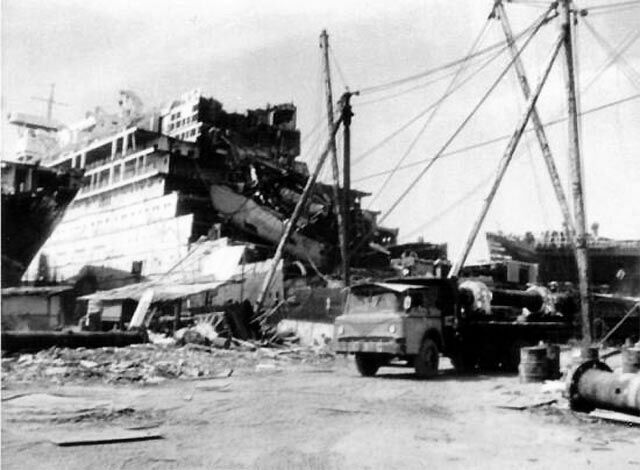
A sad sight of
what was such a fine looking ship!
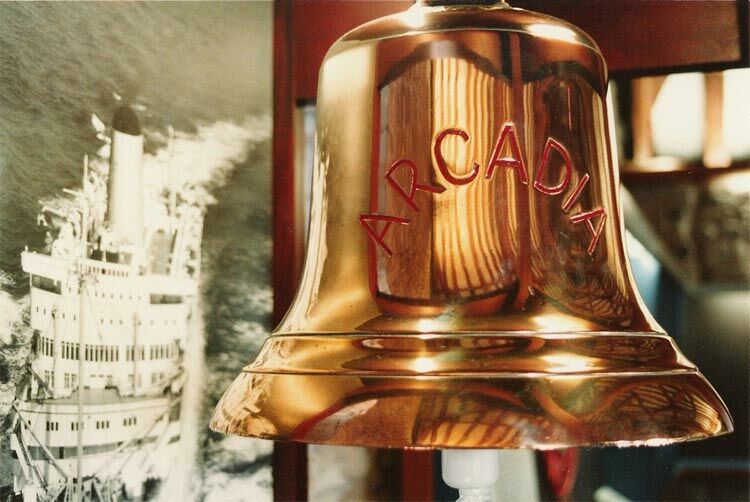
Her memory
remains, as her bell is located at the
A
Note of Interest: During “
*********************
M/V Arcadia
‘Sitmar Cruises’ was building a
revolutionary ship which was to be named the “Sitmar Fair![]() Majesty”,
but with the passing of its famous owner, his family decided to sell the
company and P&O purchased Sitmar on July 14, 1988 and officially took over
their all their ships on September 1, of that year, whilst the “Sitmar Fair
Majesty”,
but with the passing of its famous owner, his family decided to sell the
company and P&O purchased Sitmar on July 14, 1988 and officially took over
their all their ships on September 1, of that year, whilst the “Sitmar Fair![]() Majesty” was still being completed at
her fit-out berth.
Majesty” was still being completed at
her fit-out berth.

An artist’s
impression of the Sitmar![]() FairMajesty
FairMajesty
P&O transferred the “Sitmar Fair![]() Majesty” to Princess Cruises who were
in need of a larger ship in order to compete in a strong market of newer ships
and she was perfect, thus she was renamed “Star Princess”.
Majesty” to Princess Cruises who were
in need of a larger ship in order to compete in a strong market of newer ships
and she was perfect, thus she was renamed “Star Princess”.
However in November 1995, the “Star
Princess” headed for the ‘Harland & Wolff’ Shipyards in
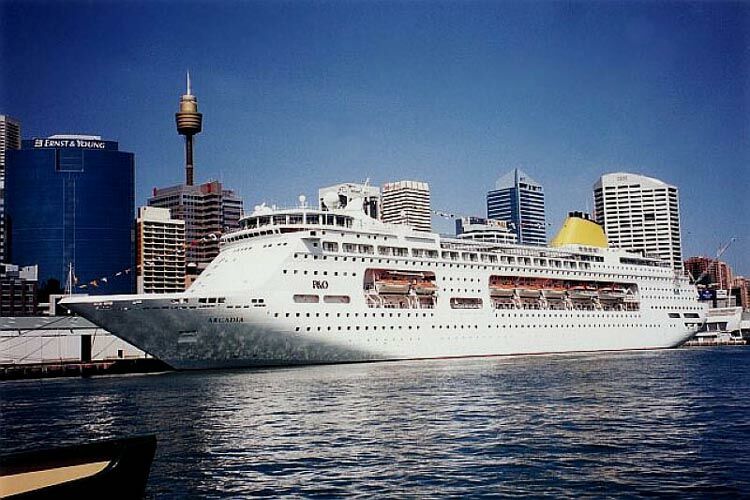
M/V Arcadia (III)
is seen at
Photograph © R. Goossens - the author
I, the author came to know the M/V Arcadia (III) very well as I actually sailed on what is called a “sector voyage” of her Maiden World Voyage and she was really a fine ship considering she was one of the early modern ships, but her interiors were simply sublime, you can view my special ‘Sitmar’ - ‘P&O’ pages which will show all her interiors being photographs I took during my wonderful time on board!
This page below has some other ships prior the “
http://ssmaritime.com/Sitmar-Cruises-other-ships.htm
The next page
(link at the bottom of the said page) has all her interiors!
*********************
Although there was a fourth, but it being a
typical Carnival (‘yuk’) ‘

The Arcadia (IV) looks more like a box on a pontoon, the a pointy end forward, the bow
But compared the
earlier
Please Note: Page Two contains Deck Plans, Menus, as well as items of S.S. Arcadia’s Souvenirs and Memorabilia and most importantly the Ships Specifications & Details. The link to Page Two is located below the next photograph.
*********************
Remembering the Much Loved
S.S. Arcadia II
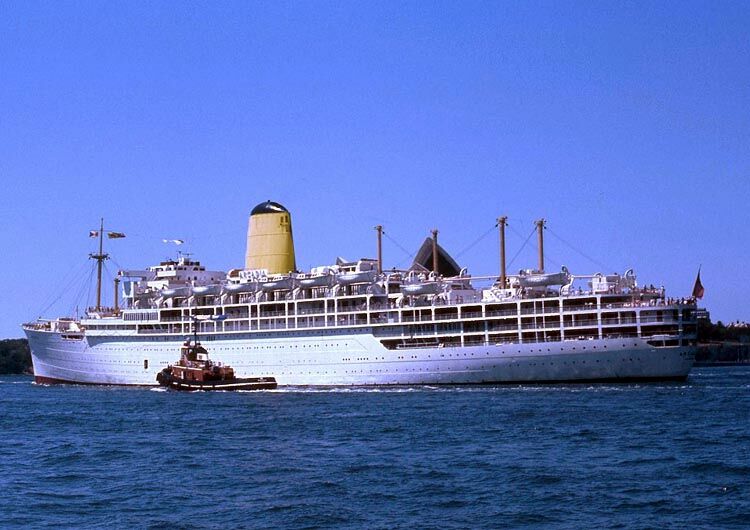
A photograph of
the much loved S.S. Arcadia departing
Enter Page Two - Here
*********************
“Blue Water
Liners sailing to the distant shores.
I watched them come, I watched
them go and I watched them die.”
Featuring over 1,550 Classic Passenger Liners, Passenger-Cargo Liners & Classic Cruise Ships!
Or ENTER HERE
For interest: Sadly an email service to ssMaritime is no longer available, due to the author’s old age and chronic illness as well as being disabled, etc. In the past ssMaritime received well over 120 emails per day, but Mr. Goossens can no longer handle same. He sincerely regrets this!
*********************
ssMaritime.com & ssMaritime.net
Where the ships of the past make history & the 1914 built M.S. Doulos Story.
The Author has been in Passenger Shipping & the Cruise Industry for well over 60 years
In addition he
was the founder of “Save the Classic Liners Campaign” in 1990.
Please Note: ssmaritime and associated sites are 100% non-commercial and the author seeks no funding or favours of any shape or form, never have and never will!
Photographs on ssmaritime and associate pages are by; the author or from the author’s private collection. In addition there are some images that have been provided by Shipping Companies and private photographers or collectors. Credit is given to all contributors. However, there are some photographs provided to me without details regarding the photographer/owner concerned.
This notice covers all pages; although, and I have done my best to ensure that all photographs are duly credited and that this notice is displaced on each page, that is, when a page is updated!
ssMaritime is owned
& © Copyright by Reuben Goossens - All Rights Reserved

